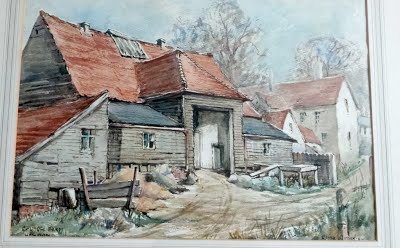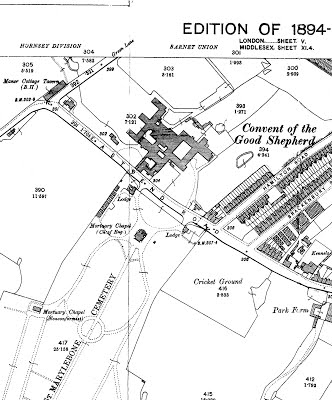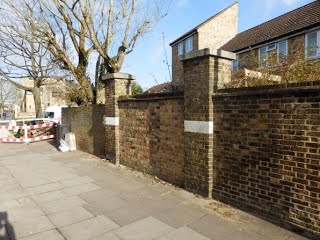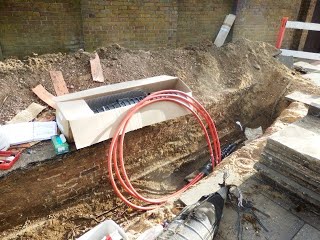No. 529 APRIL 2015 Edited by Peter Pickering
HADAS DIARY – Forthcoming Lectures and Events.
Lectures are held at Avenue House, 17 East End Road, Finchley, N3 3QE, and start promptly at 8pm, with coffee/tea and biscuits afterwards. Non-members: £1. Buses 82, 125, 143, 326 & 460 pass nearby and Finchley Central station (Northern Line), is a 5-10 minute walk away.
Tuesday 14th April 2015: The Former Inglis Barracks, Mill Hill: a small dot on a very large landscape. Lecture by Ian Cipin of Pre-Construct Archaeology (PCA)
PCA was commissioned to undertake archaeological work at the Former Inglis Barracks, recently home of the Middlesex Regiment, in advance of the redevelopment of the site. The works were carried out, in three phases, between February 2012 and July 2013 and provided tantalising glimpses into human activity across the site ranging from prehistoric periods to modern times. This talk will attempt to explain the findings but, as is frequently the case, often more questions are raised than answers are provided. Ian Cipin joined PCA in 2010 having graduated from the Institute of Archaeology at University College London. Prior to joining PCA and working in commercial archaeology he had gained extensive experience on research excavations through work in the UK, Romania, Turkey and Israel. As well as undertaking his duties for PCA Ian is also the Senior Field Supervisor and Fieldwork Tutor for the Jezreel Expedition, Israel, where he undertakes excavation and research as well as the training of graduates and undergraduates in fieldwork techniques. Tuesday 12th May 2015 Robert Stephenson; The Knights Templar and their London Connections
Tuesday 9th June 2015 ANNUAL GENERAL MEETING
Tuesday September 15th to Friday September 19th. HADAS trip
The hotel and coach are booked for our trip, with 34 members signed up. The full schedule needs to be firmed up, but will include visits to Salisbury and Old Sarum, Winchester, Beaulieu and Bucklers Hard, and Crofton pre-Victorian pumping station on the Kennet and Avon canal.
It may not be too late if you want to join, as long as hotel rooms are still available. If you are interested, please contact Jim Nelhams – see back page for contact information.
Tuesday 13th October 2015 Dr Caroline Cartwright; Scientific Methods in Archaeology Tuesday 10th November 2015 – The History of the Royal National Lifeboat Institution.
Membership Renewal Stephen Brunning, Membership Secretary
Members who pay by cheque should have received a form in last month’s newsletter or sent one by email. The HADAS membership year runs from 1st April, so all memberships are now due for renewal apart from new members who have joined since January this year. Members who pay by standing order need take no action.
Anyone who thinks they should have had a membership renewal form or standing order form but hasn’t received one, anyone who wants to Gift Aid their membership and hasn’t already done so, or anyone who has any questions please do not hesitate to contact me. (details on back page). Many thanks.
How it was – Your Local Archaeology Peter Nicholson
Would you like to know more about what was happening in your local area in past times?
This series of lectures will focus on archaeological evidence from a selection of local sites, some of which are still being excavated. Sites considered will include a temple, royal palaces, country houses and industrial sites, ranging from the post-medieval period back to Roman times. Some lectures will offer the opportunity to handle artefacts from the sites.
This course is arranged by the Mill Hill Archaeology Study Society, and will be taught by various tutors all of whom are actively involved in local archaeology.
Venue: The Eversfield Centre, 11 Eversfield Gardens, Mill Hill, NW7 2AE. Time 10.00 -12.00 on Fridays, April 10, 17, 24, May 1, 8, 15 Cost: £45 for 6 classes.
Enrol at the first meeting.
If you have not previously attended the Society’s meetings please contact the Secretary, Peter Nicholson, 020 8959 4757.
 A Legacy of Views of Hendon Don Cooper
A Legacy of Views of Hendon Don Cooper
The late John Enderby, one of our vice-presidents, who died in late 2014, left HADAS two watercolours in his will. The paintings, which we have now collected, are of Church End Farm Hendon and were painted probably in the early 1960s.
They were painted by Erina Crossley, a long term HADAS member, who died in 1988 aged 103 (another benefit of membership?). Here is a photograph (bad) of one of the paintings which shows the old barn at Miss Hinges’ farm.
 A Trench story Roger Chapman
A Trench story Roger Chapman
A funny thing happened to me on my way home from the HADAS lecture at Avenue House by Robin Densem on 10th March. I decided to walk home to East Finchley and was musing on the entertaining and informative lecture about the history of archaeology that I had just heard. As I crossed over Thomas More Way opposite St. Marylebone cemetery I spotted a utilities trench dug into the pavement. Never one to miss peering into a good trench I had a look and there staring back at me was a solid brick wall from just below pavement level to a depth of about one metre. That stopped me in my tracks. I reached for my mobile phone and took a couple of photos. They weren’t very good – it was 9.30 at night – so I decided to come back in the daylight and do a bit more research into the bargain.
Back home the 1894 Godfrey map (below) showed me that I was looking at part of the front wall of the Convent of the Good Shepherd. In 1864 the Sisters of the Good Shepherd bought East End House on the north side of East End Road, where until 1948 they maintained a refuge for distressed Roman Catholic women, including former prisoners. In 1900 they aided 180 ‘poor penitents’ and 130 younger girls. New buildings on the site included a church in 1875 and a wing for the novitiate in 1886, when East End House became the provincial house for the order. After a fire in 1972 land was sold for housing and most of the buildings were demolished, although the original house remained. http://www.britishhistory.ac.uk/vch/middx/vol6/pp86-87

 The Photos taken next morning reinforced the view that the old convent wall, when the new housing was being developed, had been knocked down but only to just below ground level or (given the amount of wall now underground) a new and higher made up ground level. The gateway through the old convent wall still stands and can be seen in the photo on the page above.
The Photos taken next morning reinforced the view that the old convent wall, when the new housing was being developed, had been knocked down but only to just below ground level or (given the amount of wall now underground) a new and higher made up ground level. The gateway through the old convent wall still stands and can be seen in the photo on the page above.
What is the lesson to learn from this story? Always keep an eye on pavement trenches, especially after you have just been to a HADAS lecture. You never know where a bit of archaeology and local history can be found.
Site Watching and Site Visits Bill Bass
3 Convent Close, off Dury Road, Barnet, Herts.
TQ 2484 9748 HADAS (Bill Bass, Don Cooper) Watching Brief Feb 2015, site code CNV15
Development work was taking place in the former garden of ‘Hadley Bourne’ a mid-late 18th century
Grade II listed building. A section of wall and footings was surveyed, approximately 20.00m (east-west) x 4.00m tall and 0.35cm wide. A further brick footing was surveyed 1.80m to the north and parallel to the main wall. Near the main wall were east-west concrete foundations and a number of concrete ‘pads’. The brick wall was constructed in English Bond; 3 ground level bricked-up arches were observed 1.20m high x 0.60cm wide, and there were a number of abutments on the south leading up to a ‘plinth line’ approximately 1.00m above ground level. The bricks were partially frogged and may have been reused. Extensive underpinning trenches had exposed wall foundations of 5-6 brick courses; beneath this some reused timber was recorded which appeared to be part of, and supporting, the foundation (?). One curved timber was 0.80cm high x 0.35cm wide x 0.15cm deep; this partly rested on a timber base-plate resting in solid London Clay. Another timber was more ‘post’ like, half-round approximately 80.00cm long x 0.30cm wide; this was set below the foundations in a thick black organic context.
The unusual plan and other features including a fire-place in a narrow space seem to point to a nonresidential building. The planning application indicated the demolition of ‘greenhouses’ and maps of 1896 show a glasshouse and out-building complex in same position in the garden. The relaxation of the ‘window tax’ and post-med pottery seen in the foundations may point to mid 19th century construction.
Former St Martha’s Junior School, 5B Union Street, Barnet, Herts EN5 4HY
This is a largish site just west of the High Street and north of Barnet Church being developed for housing. It had the chance of picking-up any medieval occupation known from the church vicinity. A former county boundary between Herts and Middlesex ran through the middle of the site so some evidence might be seen of the nature of this. Rubicon Heritage Services excavated two trenches in different parts of the site; one trench had some brick rubble, a modern service pipe and several post-med features (probably Victorian). This sat on a sandy/gravelly natural deposit. A second trench in the southern end of the site found a deep dark cultivated/garden layer, within which was a compacted sand/gravel layer thought to be a north-south garden path or similar; the cultivated layer sat on natural clay. A further trench extension is needed to find the county boundary and there will be more site-watching on the groundworks.
Clitterhouse Farm, Claremont Road, Cricklewood.
The Clitterhouse Farm Project is made up of local residents and groups who share a common interest in saving and restoring the historic Clitterhouse Farm buildings in Cricklewood. They have asked HADAS whether we could be involved in some fieldwork there as documentary evidence and maps indicate that the history of the farm may go back to the 14th century and possibly earlier. One HADAS member is actively researching the Bart’s Hospital archive as they owned the land for many years. There was a meeting at Clitterhouse Farm to discuss the possibilities along the lines of a resistivity survey and evaluation trenches; this may take place over a week in July, but is subject to confirmation.
Report on the March lecture Vicki Baldwin
Robin Densem’s March lecture was a fast-paced and diverting trip through the changes that have occurred in the practice of archaeology from the investigations of William Stukeley (1687-1765) to the present day via the founding of London and Middlesex Archaeological Society, Lane-Fox changing his name to Pitt-
Rivers, the appointment of the first Inspector of Ancient Monuments 1882, the founding of RESCUE in 1971, the Harris matrix and PPG16.
Gentlemen landowners and clergymen such as Stukeley would examine and record local landmarks and sites. Later ‘barrow-diggers’ such as Colt-Hoare and Cunningham would dig 30 to 40 barrows a year. Unfortunately their records were often inaccurate and it can be impossible to identify the locations of their endeavours. The fashion for the Grand Tour awakened an interest in collecting the antiquities of Greece and Italy. Sussex Archaeological Society was founded in 1846 and is the oldest in England. Early photographs demonstrate the division of labour by class with labourers doing the actual digging while the gentlemen directed operations and examined any artefacts uncovered.
Archaeology began to change from a pursuit for the leisured class to a paid profession in the period between the World Wars with 24 salaried archaeologists in 1922 to 4,792 including both academic and commercial in 2012. There are many disciplines that come under the umbrella of Archaeology. In addition to the professionals there are the members of local archaeological societies involved in small projects and community digs, who by taking an interest in the history and development of their locality, are the link back to Stukeley and his like.
Colchester Castle Museum Peter Pickering
I went recently with the Royal Archaeological Institute to Colchester Castle Museum. HADAS has visited it several times, most recently, I think, in 2004; it has recently reopened after a major refit. The Curator, Philip Wise, described the history of the building, built soon after the Norman Conquest on the plinth of the Roman temple of Claudius, and on the point of being destroyed to be used as building materials but saved by being given as a wedding present to Charles Gray, who was a long-serving MP for the borough. It is arguably the earliest stone castle in England, earlier even than the White Tower in London, and Philip drew important parallels between it and several other Norman castles. We had a full tour of the castle, especially the vaults – opened up when the sand round the Roman foundations was removed for building materials; the passages between the different vaults were very low – “Mind Your Head!”
The Museum’s collection is spectacular. In the refit the decision was taken to start with the Iron Age (save for the important late Bronze Age Sheepen cauldron), rather than use space to run through the prehistoric. I was struck particularly by the very strong collection of Roman glass, by the ‘Colchester vase’ (a hunting scene and four gladiators, above which are scratched the names Secundus, Mario, Memnon and Valentinus) and by the tombstones.
But the highlight of the visit was being shown the Fenwick Treasure – discovered last August when a department store was being redeveloped. Pre-construction excavation found, by the side of a Roman road, part of a building destroyed by fire; in the room, thought to be a kitchen, was a small pit, which Philip Wise said seemed to have been dug in haste with something like a dessert spoon. In it, besides a number of coins, there was jewellery, likely to have belonged to a woman – gold armlets, gold finger rings, two sets of gold earrings, silver bracelets – and on the masculine side a disc which was apparently the Roman equivalent of a military medal. The latest coins were of Claudius, and although archaeologists – as distinct from museums’ public relations people – are always reluctant to link finds with events recorded by historians it seems very likely that when Boudicca’s warriors were entering Camulodunum a retired soldier and his wife hurriedly buried their valued possessions and tried to escape. The house was burnt down, and some human remains were found, which romantics may believe were the tragic couple. The treasure is the property of Fenwicks, who are thrilled with it, and propose to put it on show this year in their Bond Street flagship store, (where perhaps some members will go to see it) and then donate it to Colchester Museum. The Museum will have to reorganise its displays so soon after its opening in order to give the treasure a prominent place.
A request for help
HADAS has received the following message. Perhaps anybody who is interested or can help would contact Father Hawkins directly
“I am trying to find someone who would be able to assist me with a local history project that I am trying to set up in the summer. The idea is to produce a history of the West Hendon estate. To facilitate this I have funding for 12 workshops that I hope will bring local residents together to build a human history of the estate; it is currently being regenerated, and I want to capture in image and prose and maybe verse something of the lives of the people who make up the estate as well as its wider history and it place in that history.
“I wonder if you have anyone who might be both knowledgeable about the local history, I would include here the A5 (Roman Road) Welsh Harp, Victorian era of trains and the story of Aeroplanes (Hendon
Aerodrome) and of course the 13th of Feb 1941 to mention a few ideas but I am sure there is more.”
— Fr John Hawkins, St John’s Vicarage, Vicarage Road,London, NW4 3PX 020 8202 8606 email – jeih.stj@tiscali.co.uk
Crossrail Liverpool Street
There are 2,000 years of history buried beneath the site of Crossrail’s Liverpool Street station, including the foundations of Broad Street railway station; the former Bedlam burial ground; Moorfields marsh; a Roman road and the Walbrook, one of London’s lost rivers.
Over the coming weeks, a team of 60 archaeologists will work in shifts, six days a week to remove skeletons and carefully record evidence for what may prove to be, in archaeology terms, London’s most valuable 16th and 17th-century cemetery site. The excavation is being undertaken by MOLA (Museum of London Archaeology) on behalf of Crossrail, ahead of the construction of a new station entrance. The progress of the dig can be followed on http://www.crossrail.co.uk/sustainability/archaeology/ liverpool-street and assorted digital social media platforms. Cross rail have arranged public viewing opportunities, as below; Public viewing gallery:
• We will be hosting public visitor sessions on site each Wednesday, Thursday and Friday from 13:00-14:00. Please note that the viewing gallery will be closed on Good Friday.
• Members of the public will be able drop-in to view the excavation in progress from our viewing gallery, see finds from the dig in a display cabinet and learn more about the incredible archaeology hidden below ground.
• Photography is not permitted during the drop-in sessions.
• These are non-ticketed sessions.
• The viewing gallery entrance is opposite the Liverpool Street site offices at 1-14 Liverpool St
EC2M 7QD
There will also be weekly archaeology team briefings:
• Each Thursday evening between 18:00-18.30 throughout the dig a member of the archaeology team will be giving a briefing on the progress on site that week.
• Photography is not permitted during the briefing sessions.
• These are ticketed events, with a maximum of 25 people per briefing on a fortnightly basis, starting Friday 20 March 2015.
• These briefings must be pre-booked via the Crossrail Eventbrite page; access from their webpage, as above.
• A series of lectures on the archaeology of Crossrail is being planned for May and June.
Other Societies’ Events Eric Morgan
Thursday 30th April. 8pm Finchley Society. Arts Depot, Tally Ho Corner, North Finchley N12 0GA. ‘Finchley in the Past’. Film and talk by members of Arts Depot Team. Also ‘The regeneration of the North Finchley Area’; talk by Kieran Kettleton of the North Finchley Town Team on the updated work of the Team.
Sunday 24th to Saturday 30th May. Arts Depot, Tally Ho Corner, North Finchley N12 0GA.’The
View from here’. Exhibition revealing the beautiful, yet frequently overlooked, features of North Finchley with a curated map of the local area by Anya Beaumont, including views inspired by the rapid development of London at the turn of the twentieth century and after the Second World War.
Sunday 3rd May. 2.30pm Heath and Hampstead Society. Meet at Burgh House, New End Square, NW3 1LT. ‘Preserving Hampstead Heath in “its natural aspect and state”. The reservoir owner’s dilemma.’ Walk led by Thomas Radice and Lynda Cook. Lasts approximately 2 hours. Donation £3.
Mondays 4th and 25th May from 11am to 5pm. Markfield Beam Engine and Museum. Markfield Road, South Tottenham, N15 4AB ‘Steam Up’ Admission Free. HADAS had a lecture on this in 2011. (Open also on Easter Monday 6th April and on the second and fourth Sundays of each month – Steaming 12.30 to 1.15, 2-2.45, 3-3.30).
Friday 8th May. 6.30pm. Friends of the Petrie Museum UCL Lecture Theatre, G6 Institute of Archaeology, 31 Gordon Square WC1. ‘Drought and the fall of the Old Kingdom’. Talk by Michael Dee.
Friday 8th May 8pm Enfield Archaeological Society Jubilee Hall, 2 Parsonage Lane/junction
Chase Side, Enfield EN2 0AJ ‘Portals to the Past: Recent Finds on the Crossrail Archaeology Programme.’ Talk by Jay Carver (Lead Archaeologist) Visitors £1. Refreshments, sales and information 7.30pm.
Monday 11th May. 3pm Barnet Museum and Local History Society. Church House, Wood Street, Barnet (opposite museum) ‘Battle of Waterloo: a Defining Moment in European History.’ Talk by Paul Chamberlain. Visitors £2.
Wednesday 13th May 7.45pm. Hornsey Historical Society. Union Church Hall, corner Ferme Park Road/Weston Park, N8 9PX ‘Flat-packed Churches.’ Talk by Marianne Zievan. Visitors £3.
Refreshments, Sales and Information 7.30pm.
Thursday 14th May 7pm. London Archaeologist. Institute of Archaeology 31-4 Gordon Square WC1. AGM and Annual Lecture ‘Making Sense of Roman London, a new archaeological history 25 years on.’ Dominic Perring.
Thursday 14th May 7.30pm. Camden History Society Camden Local Studies and Archives Centre, 2nd Floor, Holborn Library, 32-38 Theobalds Road, WC1X 8PA ‘Spies at the Isokon’. Talk by Dr David Burke. Visitors £1.
Friday 15th May 6pm St Pancras Lectures St Pancras Old Church, Pancras Road NW1
‘Rebuilding Lost Monuments’ Talk by Dan Cruikshank (with particular reference to the Euston Arch.) Tickets £10 (including drink) via www.sosstpancras.org.uk or available at the door. Fund raising to save the church. (Check for correct time as these seem to vary).
Wednesday 20th May. 7.30pm Willesden Local History Society, St Mary’s Church Hall, Neasden Lane NW10 2TS (near Magistrates’ Court) ‘The Ace Cafe’. Talk by Mark Wilsmore (about its long history for bikers, etc).
Friday 22nd May. 7.30pm Wembley History Society. English Martyrs’ Hall, Chalkhill Road, Wembley, HA9 9EW (Top of Blackbird Hill, adjacent to Church) ‘The Wembley Way’ Talk by Simon Inglis on West London’s Sporting Heritage. Visitors £2.
Wednesday 27th May. 7.45pm Friern Barnet and District Local History Society. North
Middlesex Golf Club, The Manor House, Friern Barnet Lane N20 0NL. John Donovan Memorial Lecture by Jim Corbishley. ‘Coins’ Preceded by AGM. Non-members £2. Refreshments and Bar open before and after talk.

